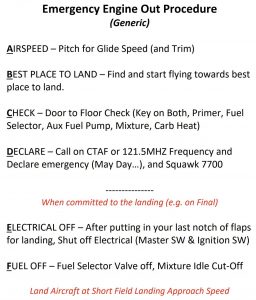Committing an Emergency Engine Out Procedure to Memory Could Save your Life
The sound of instant silence as the result of an aircraft losing its engine while in flight is a real shocker to any pilot who has experienced that situation. However, it does not mean its necessarily the end of your world, literally, if you’ve trained properly and regularly for that event, and keep your wits about you.
When flying general aviation aircraft, it should be ingrained in student pilots’ heads that they should expect to someday lose their aircraft’s engine when out flying. Consequently, it should be reinforced with student pilots that it is not a matter of IF their aircraft may lose its engine someday, but rather WHEN their aircraft loses their engine.
With that mindset fully planted in the student pilot’s head, they should have an easier job of committing to memory the necessary steps that are immediately necessary when dealing with the loss of the aircraft’s engine. Below are the six steps that I suggest student pilots, as well as already certificated pilots, commit to memory for dealing with an emergency engine out situation.

Altitude conservation is a must when losing an engine, and to that end getting to best glide Airspeed quickly is critical. In a cruise flight situation when losing the engine, this means holding the nose of the aircraft in a level attitude, or possibly slightly pitching up and grabbing a few more feet in altitude as you get the aircraft slowed down to best glide speed. On the flip side, if you lose the engine on take-off it is critical to get the aircraft’s nose down immediately while pitching for best glide speed. Otherwise, a stall will likely happen.
Once the airspeed is under control, finding the Best place to Land is next. A general aviation pilot should always be keeping an eye out for possible emergency landing areas, such as fly-by/over airports, fields, lakes or ponds, and even roads. While dialing in and trimming the aircraft for best glide speed, the pilot should be simultaneously flying in the direction of the emergency place to land.
While flying towards the emergency landing area determine the best position to land on it. Specifically, note its orientation to the expected surface winds and plan to land into the wind. This will help you establish in your mind the effective downwind, base and final leg for the approach to landing.
If you arrive at the emergency landing area with a lot of altitude to lose that’s a good thing. Circle / spiral down over the approach end of the landing area and roll out when you are on a short downwind at or slightly above 1000 feet AGL (pattern altitude).
If necessary, do S-Turns as you approach on final. It is better to come in a little high than too low. You have many tools to get you down, such as flaps and forward slips, as well as the S-turns, but nothing to regain altitude if you come up short. Again, you lost your engine, so now “POWER for altitude” possible in this situation.
Once on Airspeed and Best place to Land, CHECK your fuel and ignition systems. I liked to do a flow, like “Door to Floor” starting at the left and working my way across the panel to the right and then downwards to the floor for the trim and flaps. Make sure to check the fuel tanks and if need be, switch fuel tanks. Check that the primer knob is in and locked, that the mixture is rich, the carb heat is on and the auxiliary fuel pump is on.
Next, Declare the emergency. On the current CTAF/UNICOM frequency (or 121.5 MHz – Guard) transmit MAYDAY, MADAY, e.g. Skyhawk N73XXX is going down with an engine out 5 miles South of airport Kxxx. Then squawk 7700 and unlock the doors on the plane.
Now pull out your aircraft’s Emergency Engine Out checklist and make sure you’ve not missed anything in that checklist.
When on final approach to the emergency landing area, turn off your Electrical system, but only after you’ve put in all your flaps if you have electrically controlled flaps. Simply turn off the master switch to shut down the electrical system.
Next turn off your Fuel system including: the fuel selector to off, the mixture to cut-off idle, and any fuel pumps off.
Finally, on final approach come in at a short field landing airspeed and landing with a tail low pitch attitude.
If these six steps can be memorized like a child memorizes a nursey rhyme, a pilots tunnel vision that immediately happens when a crisis like this occurs will fade quickly and the pilot will act more deliberately in the crisis and have a much better chance of a positive outcome.
I will reiterate, however, to all I have described above. Always reference the aircrafts Pilot Operating Handbook for performing all procedures, including the emergency procedures.
